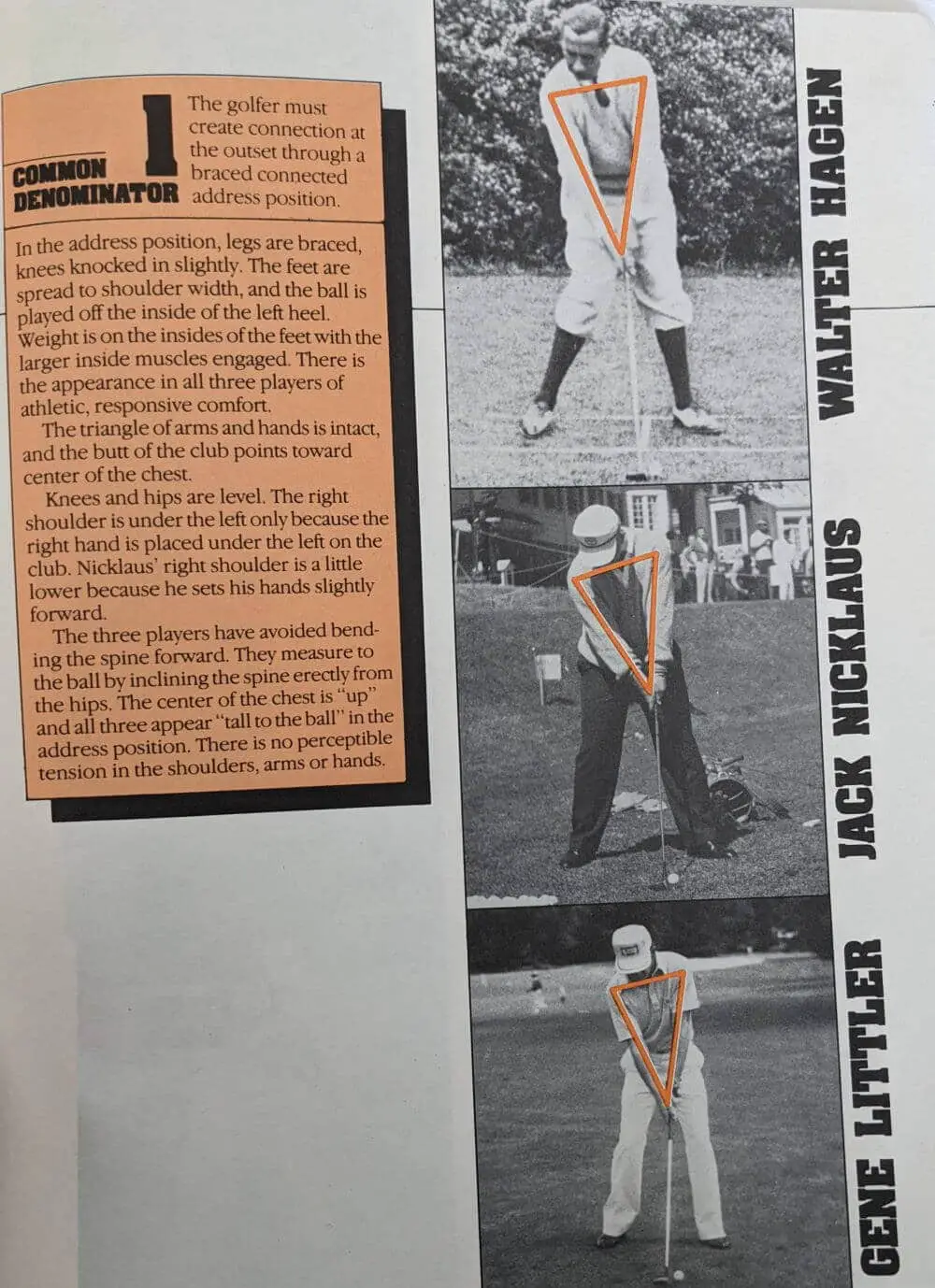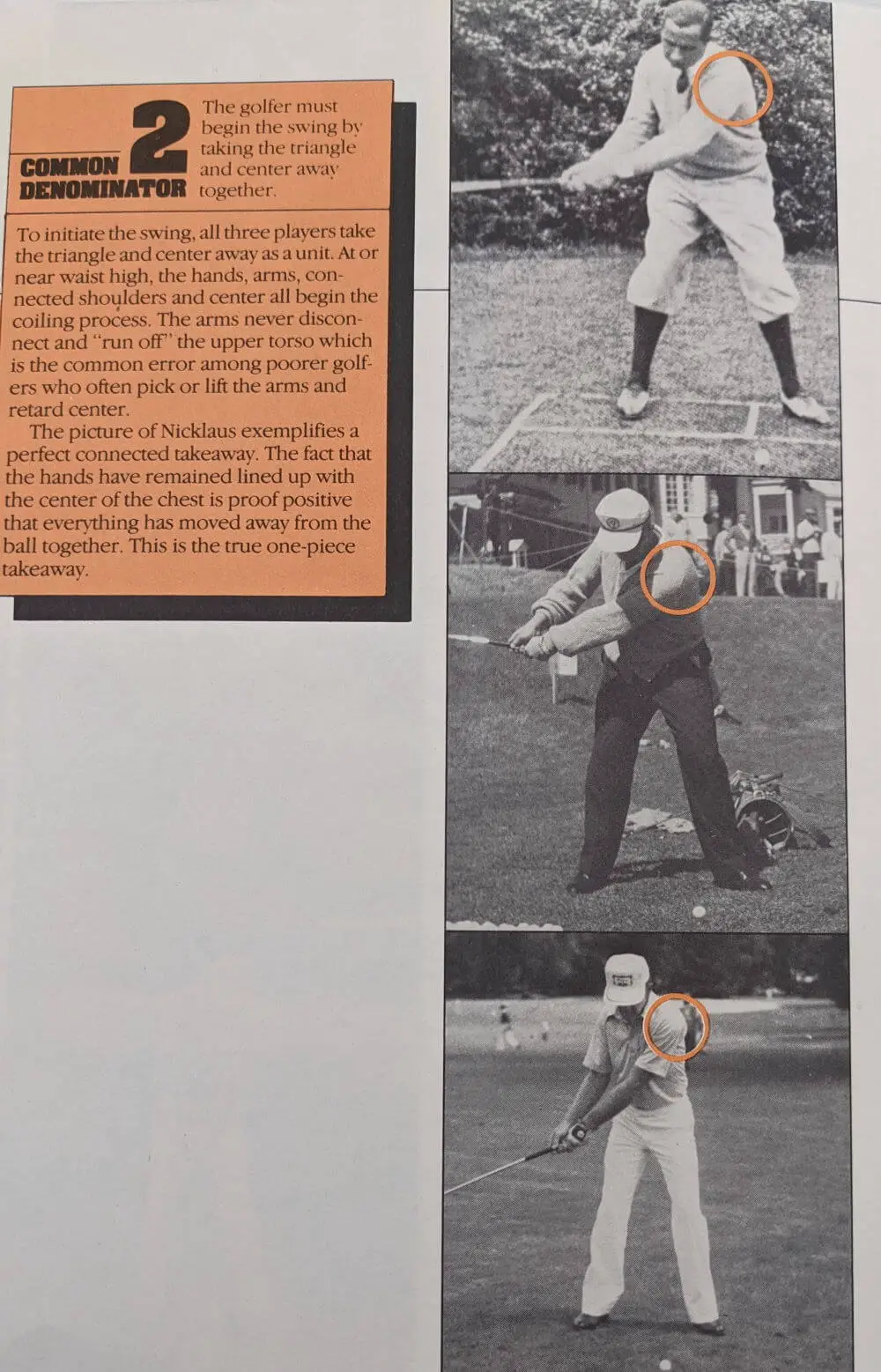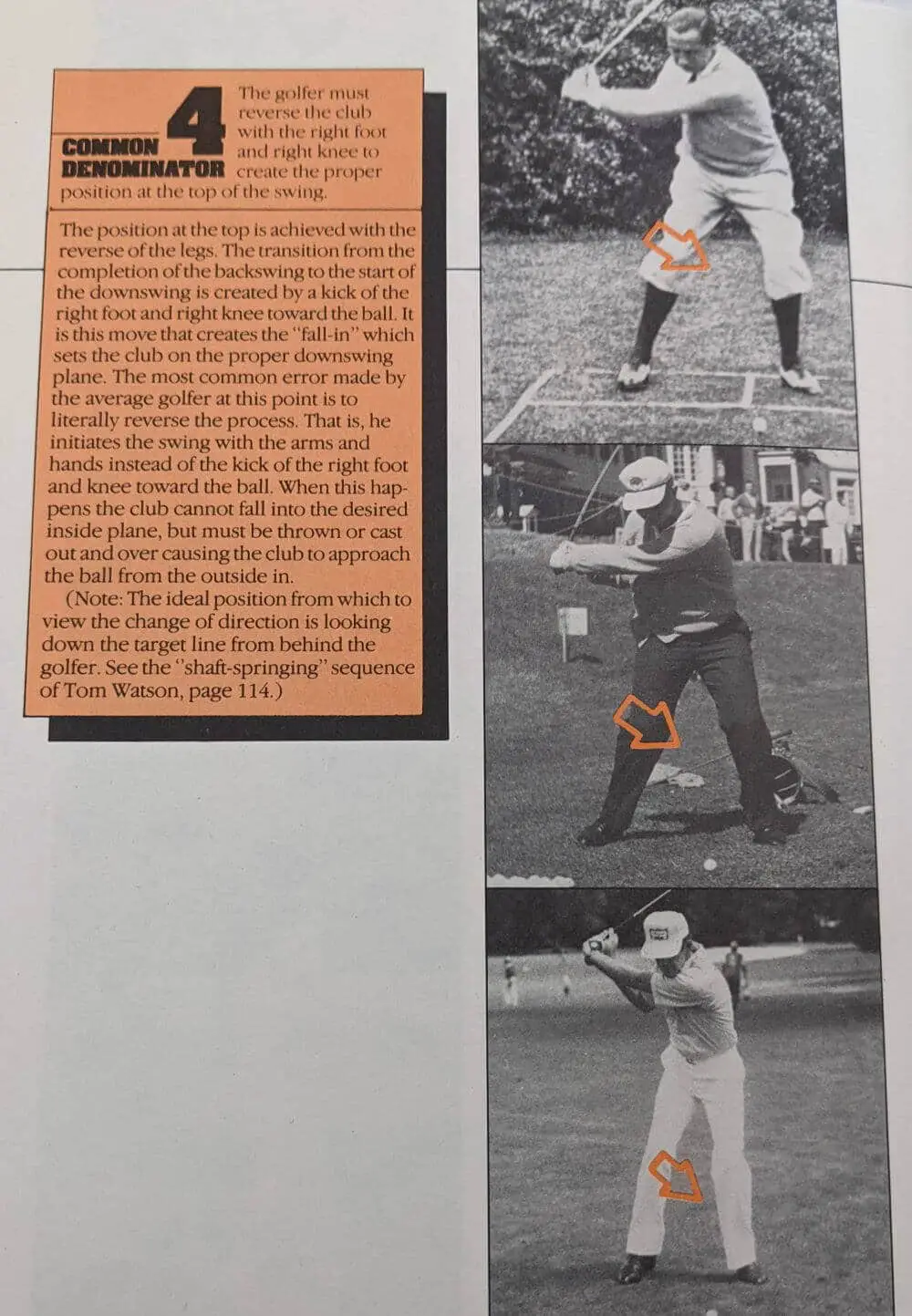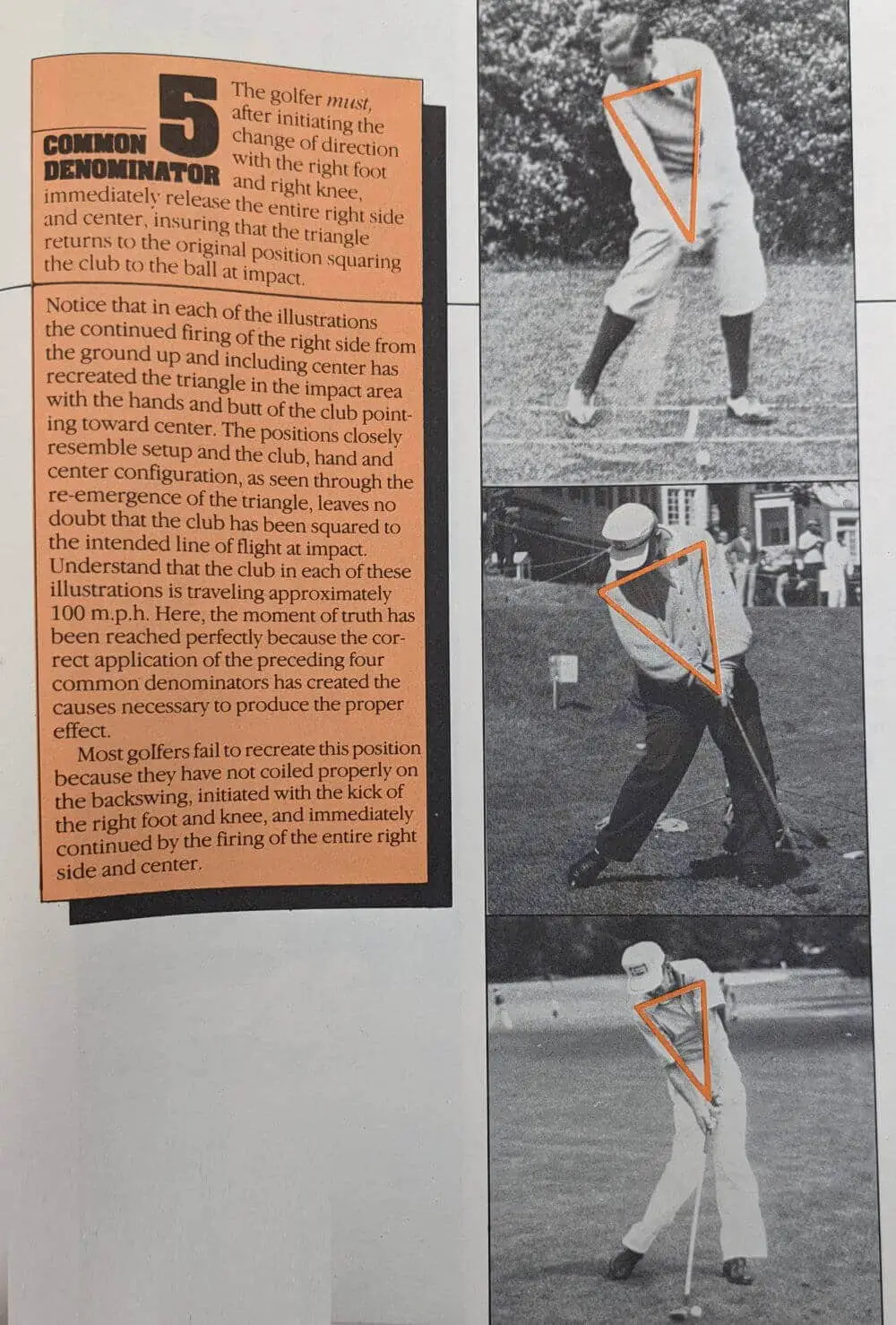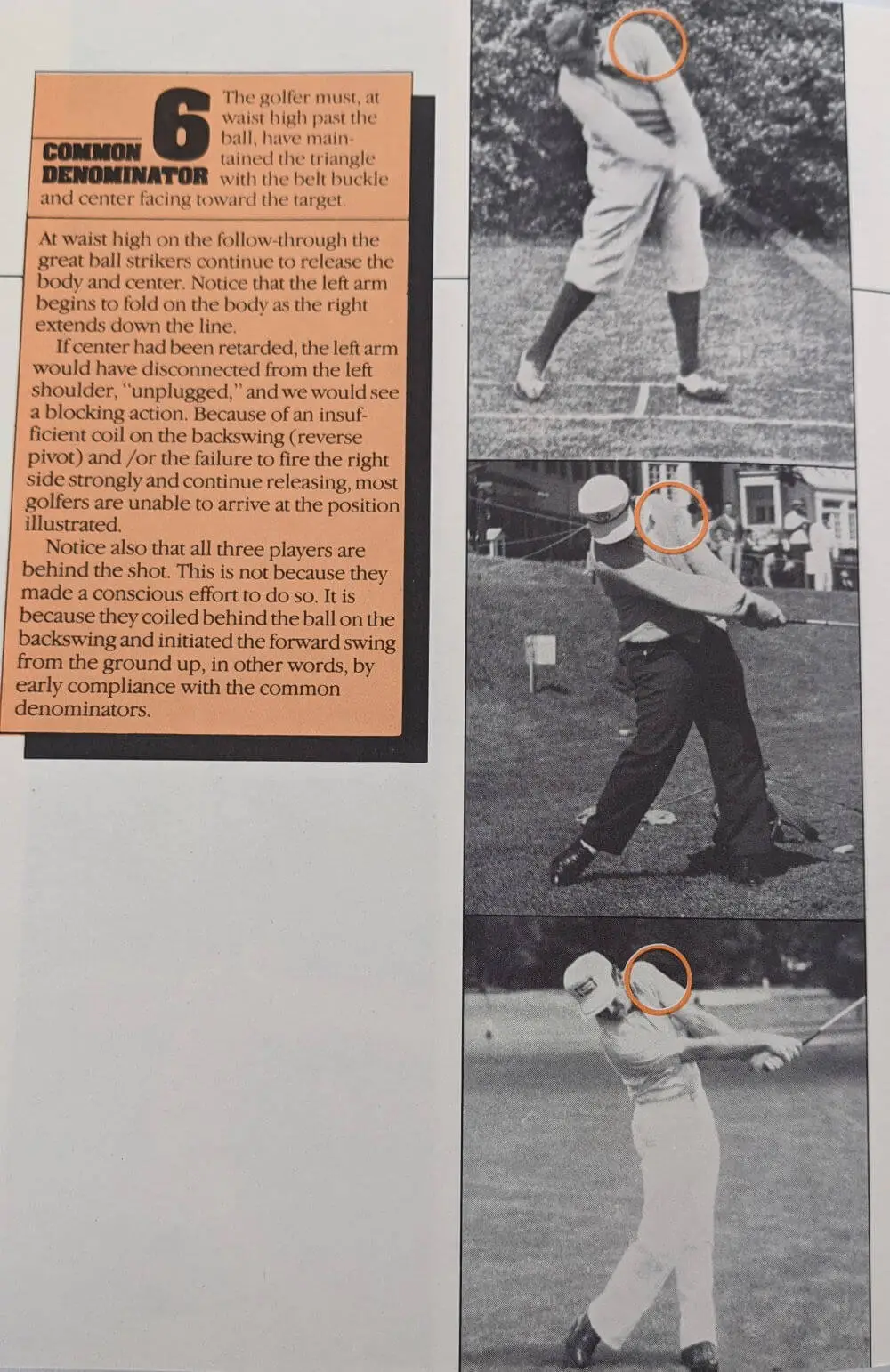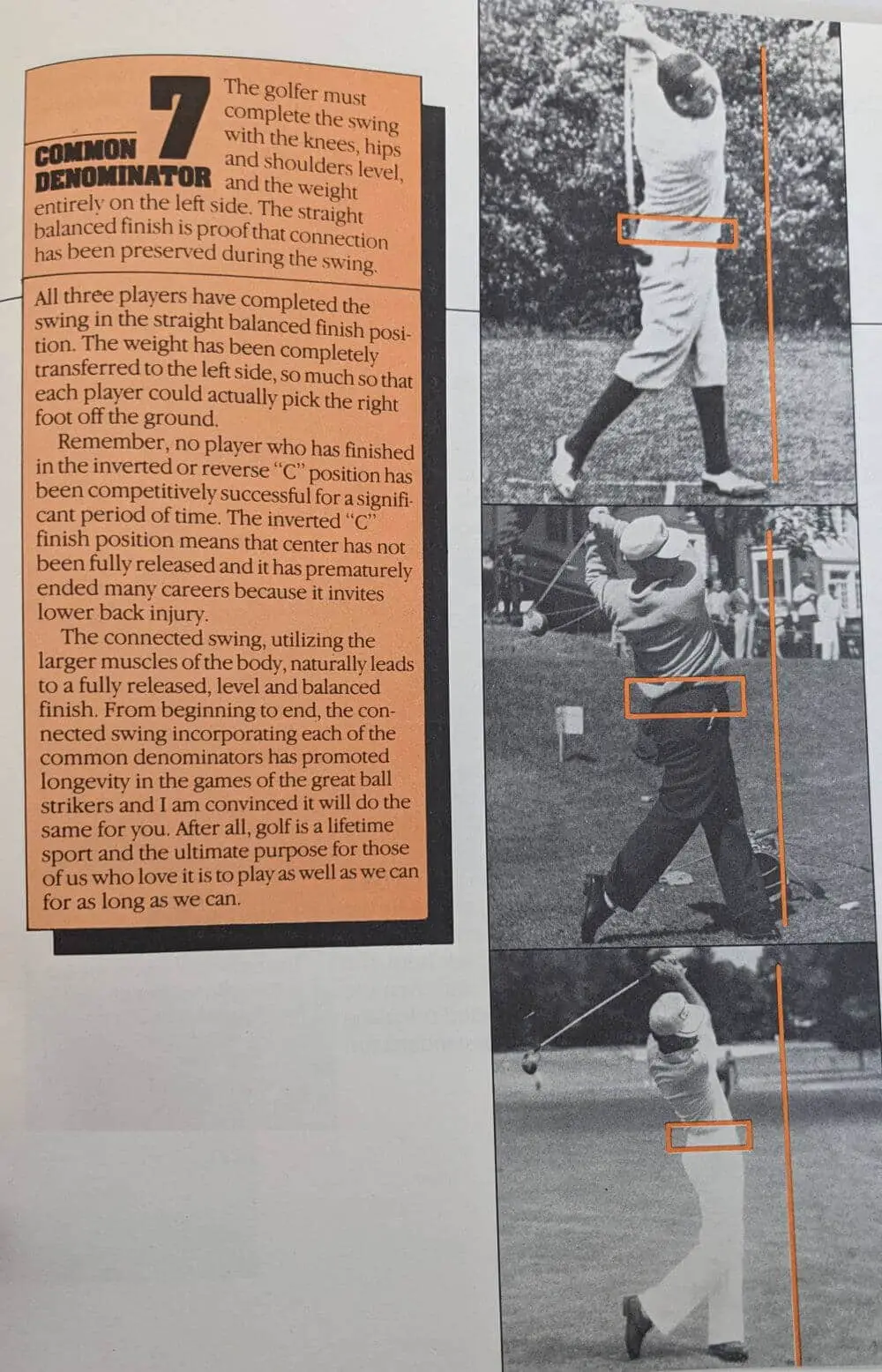Common Denominator 1 - The golfer must create connection at the outset through a braced connected address position.
In the address position, legs are braced, knees knocked in slightly. The feet spread to shoulder width, and the ball is played off the inside of the left heel. Weight is on the insides of the feet with the larger inside muscles engaged.
There is the appearance in all three players of athletic, responsive comfort. The triangle of arms and hands is intact, and the butt of the club points toward center of the chest. Knees and hips are level. The right shoulder is under the left only because the right hand is placed under the left on the club. Nicklaus’ right shoulder is a little lower because he sets his hands slightly forward.
The three players have avoided bending the spine forward. They measure the ball by inclining the spine erectly from the hips. The center of the chest is “up” and all three appear “tall to the ball” in the address position. There is no perceptible tension in the shoulders, arms or hands.
As the first denominator, it is pretty clear that Ballard believes that connection starts in the way that you address the ball. In essence:
- A strong triangle is created by the hands, arms and shoulders.
- The ball is played off the inside of the left heel
- Each player’s head is well behind the ball, almost in line with the right knee
- The hips are level
- The right shoulder is lower than the left shoulder,
- The chest is ‘up’ rather than slouched
Common Denominator 2 - The golfer must begin the swing by taking the triangle and center away together.
To initiate the swing, all three players take the triangle and center away as a unit. At or near waist high, the hands, arms, connected shoulders and center all beginn the coiling process. The arms never disconnect and run off” the upper torso which is the common error among poorer golfers who often pick or lift the arms and retard center.
The picture of Nicklaus exemplifies a perfectly connected takeaway. The fact that the hands have remained lined up with the center of the chest is proof positive that everything has moved away from the ball together. This is the true one-piece takeaway.
In this particular denominator, it’s clear to see that Ballard is a believer in the one piece takeaway. He wants the triangle of the arms, hands and clubs to move together as a unit.
Ballard is effectively telling golfers how to achieve connection during the first part of the backswing. Ballard also expresses his disregard for the tendency ‘pick the club up’ during the initial part of the backswing. In his mind, picking the club up too early automatically creates disconnection.
Common Denominator 3 - The golfer must coil the triangle and center behind the ball into the brace of the right leg
By continuing the connected coiling on the backswing, all three players have moved totally behind the ball so that the weight is loaded into the inside of the right foot, leg and the inside of the right hip joint.
The head and the upper torso have moved to the right but none of these players has swayed.
As explained earlier, golf’s most common disconnection is that sway forward or the reverse pivot (as it is commonly called).Unless the golfer coils as deeply as possible into the brace of the right leg, maximum potential cannot be reached.
Ballard’s third denominator is important, because many people falsely believe that he advocates a ‘sway’ off the ball during the backswing and a ‘sway’ into the ball during the follow-through.
In reality, Ballard is an avid believer in the importance of coiling fully into the right side. Ballard is effectively saying that in order to hit the ball as far as you possibly can, you need to load fully into your right side. While there is a degree of lateral movement away from the ball, the players weight always remains on the inside of the right leg rather than the outside of the right leg.
Lastly, Ballard also views ‘coiling into the right side’ as the logical antidote to a reverse pivot.
Common Denominator 4 - The golfer must reverse the club with the right foot and the right knee to create the proper position at the top of the swing.
The position at the top is achieved with the reverse of the legs. The transition from the completion of the backswing to the start of the downswing is created by a kick of the right foot and right knee toward the ball. It is this move that creates the “fall-in” which sets the club on the proper downswing plane.
The most common error made by the average golfer at this point is to literally reverse the process. That is, he initiates the swing with the arms and hands instead of the kick of the right foot and knee toward the ball. When this happens the club cannot fall into the desired inside plane, but must be thrown or cast out and over causing the club to approach the ball from the outside in.
As you can see from the explanation of this denominator, Ballard wants his students to initiate the downswing with a ‘kick of the right foot and right knee toward the ball’. The problem is that Ballard never mentions the importance of planting the left foot during the downswing.
From our perspective, you can only ‘fire the right side’ after you have planted the left foot. Planting the left foot allows you to pivot around the left hip while you unleash the power stored in your right side.
By omitting this important step, Ballard’s entire downswing theory is subject to misinterpretation. We regard his description of how to start the downswing as the worst part of his golf philosophy. It’s like Ballard is so focused on the right side that he doesn’t even mention the immense importance of the left side.
Common Denominator 5 - The golfer must after initiating the change of direction with the right foot and right knee, immediately release the entire right side and center, insuring that the triangle returns to the original position squaring the club to the ball at impact.
Notice that in each of the illustrations the continued firing of the right side from the ground up and including the center has recreated the triangle in the impact area with the and butt of the club pointing toward the center.
The positions closely resemble setup and the club, hand, and center configuration, as seen through the re-emergence of the triangle, leaves no doubt that the club has been squared to the intended line of flight at impact.
Understand that the club in each of these illustrations is traveling approximately 100 mph. Here, the moment of truth has been reached perfectly because the correct application of the preceding four common denominators has created the causes necessary to produce the proper effect.
Most golfers fail to recreate this position because they have not coiled properly on the backswing, initiated with the kick of the right foot and knee, and immediately continued by the firing of the entire right side and center.
Common Denominator 6 - The golfer must, at waist high past the ball, have maintained the triangle with the belt buckle and center facing toward the target.
At waist high on the follow-through the great ball strikers continue to release the body and center.
Notice that the left arm begins to fold on the body as the right extends down the line.If center had been retarded, the left arm would have disconnected from the left shoulder, “unplugged”, and we would see a blocking action. Because of an insufficient coil on the backswing (reverse pivot) and or the failure to fire the right side strongly and continue releasing, most golfers are unable to arrive at the position illustrated.
Notice also that all three players are behind the shot. This is not because they made a conscious effort to do so. It is because they coiled behind the ball on the backswing and initiated the forward swing from the ground up, in other words, by early compliance with the common denominators.
It is important to note that Ballard doesn’t want players to arrive at this position (where they are behind the shot) by attempting to ‘keep their head behind the ball’.
In essence, each of the players has executed an efficient release, where the energy stored in the right side of the body is unleashed through impact.
The players appear ‘behind the shot’ because they haven’t ‘swayed toward the target’. You could say that they have fired the right side, but with minimal swaying toward the ball. One thing is irrefutable. Each of these magnificent ball strikers never gets ‘ahead of the ball’ through the impact area.
Common Denominator 7 - The golfer must complete the swing with the knees, hips and shoulders level, entirely on the left side. The straight balanced finish is proof that connection has been preserved during the swing.
All three players have completed the swing in the straight balanced finish position. The weight has been completely transferred to the left side, so much so that each player could actually pick the right foot off the ground.
Remember, no player who has finished in the inverted or reverse “C” position has been competitively successful for a significant period of time. The inverted “C” finish position means that center has not been fully released and it has prematurely ended many careers because it invites lower back injury.
The connected swing, utilizing the larger muscles of the body, naturally leads to a fully released, level and balanced finish. From beginning to end, the connected swing incorporating each of the common denominators has promoted longevity in the games of the great ball strikers and I am convinced it will do the same for you.
After all, golf is a lifetime sport and the ultimate purpose for those of us who love it is to play as well as we can for as long as we can.
It is fundamentally clear that Ballard despises the reverse C finish position, where the spine is bent rather than erect at the completion of the follow through. Instead, Ballard wants players to finish the swing with their spine upright, with their weight fully transferred to the left side.
Ballard references Byron Nelson as a golfer who exemplifies the ideal finish position. In modern times, Henrik Stenson and Anika Sorenstam are two players who can also serve as excellent models for Ballard’s swing philosophy, especially in terms of how to maintain their spine angle throughout the swing, and finish the swing with their spine straight.


